#q.ko-chan the earth invader girl
Explore tagged Tumblr posts
Text

hajime ueda’s q.ko-chan the earth invader girl || ウエダハジメの『QコちゃんTHE地球侵略少女』
#hajime ueda#ウエダハジメ#q.ko-chan the earth invader girl#qko-chan the chikyuu shinryaku shoujo#QコちゃんTHE地球侵略少女#b&w#mangacap
60 notes
·
View notes
Text
Q.Ko-Chan: the Earth Invader Girl
Manga Review
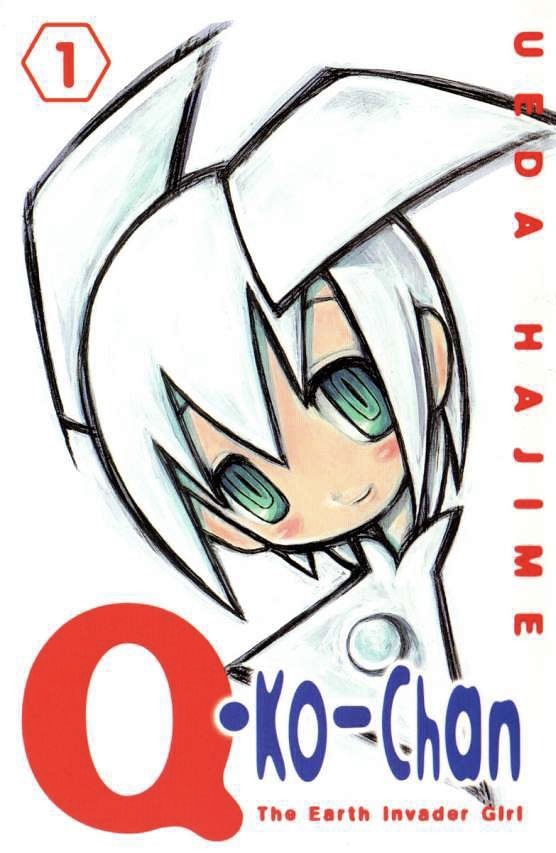
Q.ko-chan is a very odd manga. So much so that I’m going to start with something at the end of it. Immediately after the conclusion of its story, the English edition of Q-ko greets us with a segment written by the translator of the series titled “so what happened?”, in which he states the confusion readers feel from the work is present across all versions, and not a kink of the cultural barrier. He even ends the segment by stating you, the reader, should “feel free to write us if you know the answers.”
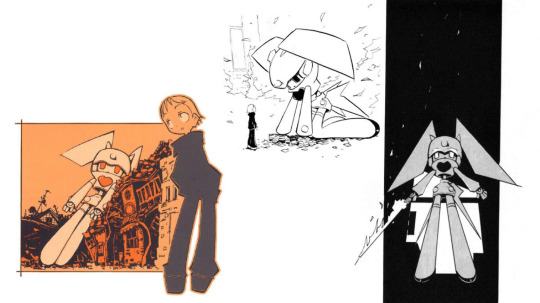
Q.ko-chan: the Earth Invader Girl, is a manga series written and illustrated by Hajime Ueda. Originally serialized in the now-defunct ‘Monthly Magazine Z’ anthology from 2003 to 2004, and later translated into English by, the also now-defunct, Del Rey Manga in 2006, the series is two volumes in length and roughly spans 400 pages. As the title may suggest, the series centers on an alien, the titular Q-ko-chan. Q-ko and several other “Doll”-like alien girls have come to earth in an alternative, more war-torn future to our own. The Doll alien girls have the stated objective of being the “welfare guardians” of the planet’s children. This task consists of allowing the children to “pilot” them. Piloting in the series is basically what it sounds like. A kid gets in the Doll girl’s belly and can fly them around and shoot lasers and basically do big fun robot stuff. However, as these kids live in the chaotic and violent world they do, this more often than not results in conflict. Be it with 3rd party aliens that aren’t the dolls, other doll-flying kids, or just random people on the street the kid with the robot doesn’t like. While Q-ko-chan is the title character, the most central characters in the series are easily Kirio Muji, a young boy who is almost certainly a psychopath, and his older sister Furiko.
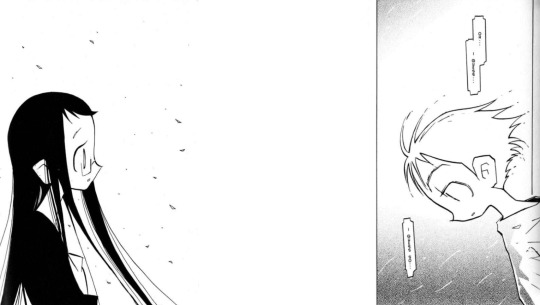
Furiko was born a frail girl. She requires a lot of looking-after and this causes her a great deal of insecurity. She’s internalized the idea that her mother only decided to have her younger brother, Kirio, because she wasn’t good enough for her. She envies him greatly. Kirio does not understand his sister. He doesn’t understand most people, in fact. At first glance he seems like a normal kid, but he treats those he doesn’t already favor’s physical well-being with a reckless abandon not seen in most people. He eggs his sister into passing out so he doesn’t have to deal with her talking. He tries to kill some bullies that gave his friend a hard time with his giant robot. This side of him isn’t appreciated by the people in his life, and he’s routinely called out for it. Kirio, despite this, wants to be understood. He doesn’t understand empathy in the same way others do, but this doesn’t mean he’s not a person. He’d like it if all his friends, whose opinions he values, were fine with everything about him, but that’s not how it is. So the next best thing for him to do is to try to understand others. He succeeds in some cases, but his sister, and what she “sees, wishes, and hates” is still a mystery to him. It is through this inability to understand his sister, and his sister’s envy towards him, that the two are forced into conflict at the climax of the series. From what I can gather, the series’ main theme is childhood purity. Or rather, the lack thereof. The dolls are there to save the children from the harmful world around them, but the children prove to be tainted as well. As a protagonist, Kirio is the perfect encapsulation of this theme. Q.ko and Kirio’s friends want him to be better, and he tries, but he’ll never be perfect.
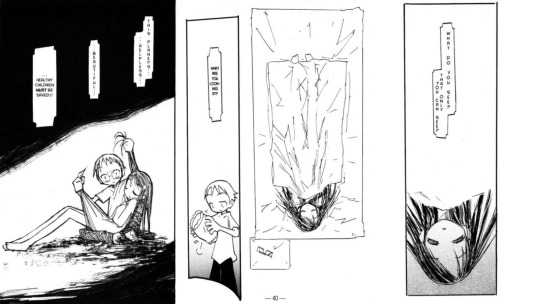
The series’ artwork is very much that of a brand Hajime Ueda has all to himself. His use of negative space feels rich and unique, his character designs are cute and sleek, and it seems like he never uses more detail than he must in order to get anything across. I’d wager most of the people checking out this series nowadays are doing so because of his work on various sequences in the Monogatari series. Although, I’d be lying if I said I didn’t find the art in Q.ko confusing at times. It’s hard to tell if this is a result of the confusing story it’s conveying or the art itself, though. Q.ko-Chan, to date, is the last manga series Ueda has worked on. From the limited pool of his stories that exist, he looks like a passionate writer, so It’s always been odd to me that he seemingly abandoned the medium of manga (and storytelling in general) to do artwork for series that aren’t his. I’d love to see him do another story of his own someday.
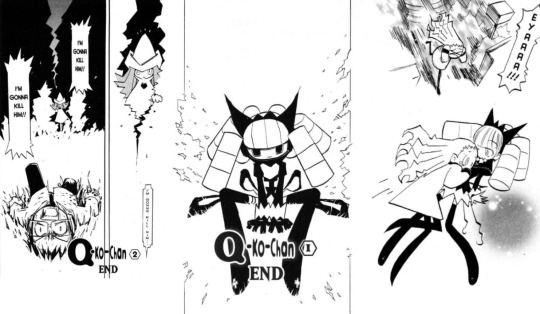
In Q.ko-chan, the subtext is the text. If you’ve ever seen or read FLCL, this basically feels like that. And I say that completely divorced from the fact that Hajime Ueda is responsible for the manga adaptation of FLCL. It has the same vibe and confusing jargon thrown around everywhere without an attempt to make complete grounded sense, with a thematic throughline focusing on kids’ feelings present. While I find the central plot with Kirio and Furiko compelling, there was a lot I just couldn’t bring myself to care for. I was interested in the kids’ mom, but beyond her, the focus on the characters in the military seemed kind of extraneous. I could tell there was *something* there, but it just wasn’t clicking for me. I’m open to the idea of finding more of a purpose for those parts of the story on future readthroughs, but for now it just weighs down the whole for me. There is a lot of filling in the blanks yourself needed in this manga and it’s definitely a series you need to think about for a bit before you can feel like you really “finished” it. I liked the story when I could tell what was happening and what its intent was. I feel like I’ve mostly got a handle on the themes and how the series executes them, but I don’t think I’m ever going to fully understand this thing. That’s part of the fun to be had with it, though.
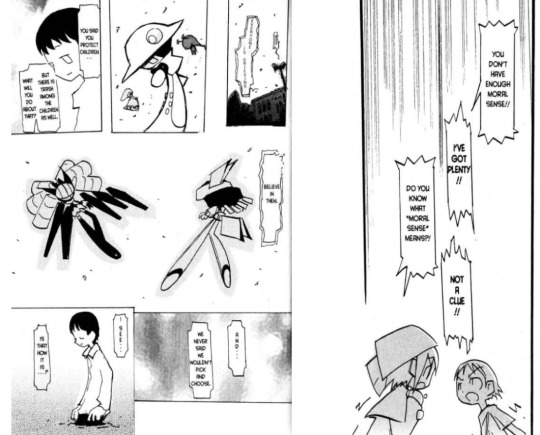
#ueda#hajime#ueda hajime#hajime ueda#q.ko-Chan#monogatari series#monogatari#flcl#fooly cooly#manga#q.ko#qkochan#qko#q-ko-chan#q-ko#review#manga review#manga analysis#character analysis#writeups#del rey#giant robot#robot girl#nisioisin
278 notes
·
View notes
Photo

hajime ueda’s q.ko-chan the earth invader girl || ウエダハジメの『QコちゃんTHE地球侵略少女』
#hajime ueda#ウエダハジメ#q.ko-chan the earth invader girl#qko-chan the chikyuu shinryaku shoujo#QコちゃんTHE地球侵略少女#b&w#mangacap
70 notes
·
View notes
Photo

hajime ueda’s q.ko-chan the earth invader girl || ウエダハジメの『QコちゃんTHE地球侵略少女』
124 notes
·
View notes
Photo

hajime ueda’s q.ko-chan the earth invader girl || ウエダハジメの『QコちゃんTHE地球侵略少女』
#hajime ueda#ウエダハジメ#q.ko-chan the earth invader girl#qko-chan the chikyuu shinryaku shoujo#QコちゃんTHE地球侵略少女#b&w#mangacap
1K notes
·
View notes
Photo

hajime ueda’s q.ko-chan the earth invader girl || ウエダハジメの『QコちゃんTHE地球侵略少女』
#hajime ueda#ウエダハジメ#q.ko-chan the earth invader girl#qko-chan the chikyuu shinryaku shoujo#QコちゃんTHE地球侵略少女#b&w#mangacap
113 notes
·
View notes
Photo

hajime ueda’s q.ko-chan the earth invader girl || ウエダハジメの『QコちゃんTHE地球侵略少女』
#hajime ueda#ウエダハジメ#q.ko-chan the earth invader girl#qko-chan the chikyuu shinryaku shoujo#QコちゃんTHE地球侵略少女#b&w#mangacap
162 notes
·
View notes
Photo

hajime ueda’s q.ko-chan the earth invader girl || ウエダハジメの『QコちゃんTHE地球侵略少女』
#hajime ueda#ウエダハジメ#q.ko-chan the earth invader girl#qko-chan the chikyuu shinryaku shoujo#QコちゃんTHE地球侵略少女#b&w#mangacap
101 notes
·
View notes
Photo

hajime ueda’s q.ko-chan the earth invader girl || ウエダハジメの『QコちゃんTHE地球侵略少女』
#hajime ueda#ウエダハジメ#q.ko-chan the earth invader girl#qko-chan the chikyuu shinryaku shoujo#QコちゃんTHE地球侵略少女#b&w#mangacap
45 notes
·
View notes